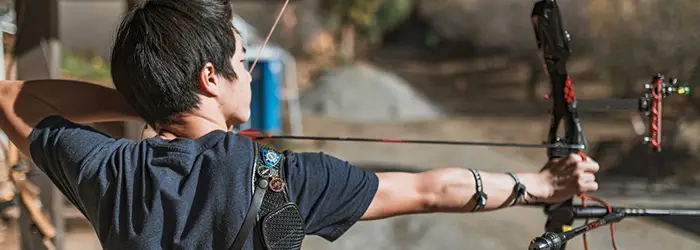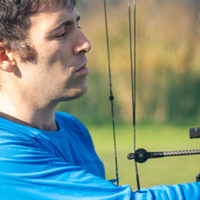Recurve bows have a fascinating history that dates to the medieval ages. They are known for delivering more energy for less energy. Nowadays, archers use recurve bows for recreational shooting and bowhunting. So, are recurve bows good for hunting?
Recurve bows are good for hunting, and many bowhunters choose to carry recurve bows. They are silent, easy to carry, and accurate. However, it is a bit harder to shoot the proper draw weight for bow hunting on a recurve bow.
In this post, we’ll consider whether you should use a recurve bow for bowhunting, and the different aspects of the bow. Let’s go!
Why recurve bows are good for hunting
Before you use a recurve bow, you must have a deep understanding of the bow. It features a unique curved shape, so the user can deliver a higher amount of energy than other bow types. Also, it allows for increased speed when shooting. Here are some advantages of using recurve bows when hunting.
Draw weight
As you hunt, you want to kill your prey quickly with the weapon. The arrow should enter the animal swiftly. Many recurve bows feature high draw weight. If you’re hunting a whitetail deer, you need a draw weight of 45 to 55 pounds. This is enough to reach the vitals of the animal in 20 yards or less.
Novice hunters should choose a bow with a draw weight they can handle. If you’re an adult male between 150-180 lbs., you need a draw weight of 40-55 lbs. Similarly, if you weigh 130 to 160 pounds, the ideal draw weight is 25 to 35 pounds.
Make sure the weight is not too much for the muscles, as this may compromise your aim.
Noise
If your bow makes a lot of noise, you can lose the animal in sight. Recurve bows are almost silent because of the materials they are made with, and because they don’t have a lot of running complex mechanisms. Once you master instinctive shooting, you can aim faster.
Overall bow length
Recurve bows have a good length, and this makes them easy to shoot the target. For most beginners, a 58-inch recurve bow is a good one. If you’re an experienced hunter, you can choose more than a 60-inch longbow. A longer weapon means that you can hunt down bigger animals. If you want to draw the arrow to 200 yards, you may need a 31-inch bow or more.
The size of the recurve bow affects your shooting accuracy. When properly sized, the bow will prevent physical pain, and you won’t miss your target.
Ease of carry
Recurve bows are lightweight, so you can hold for longer within the range. This also makes it easier to practice your hunting skills more frequently. On average, a recurve bow weighs two to four pounds. If your bow is heavier than this, you may want to reconsider something lighter.
When choosing a recurve bow, you can choose a take-down or a heavy bow. A take-down recurve bow is easier to transport because you can remove the limbs easily and store them in a bag.
If you carry a heavy weapon to the bush, you can wear your body down. A lightweight recurve bow is ideal, especially if you have to wait for many hours to spot your target.
Adjustability
You can adjust your recurve bow to increase the draw strength. It gets better if you choose a bow with takedown limbs. As you improve your hunting abilities, you can customize the bow even further. If your bow has more than one limb, you may want an attachment like a bow sight.
Other accessories include bow stringers, targets, arm bows, and a broadhead wrench.
Accuracy
A recurve bow is accurate and guarantees the precision of shots. Some have fiberglass laminations, so you should expect recurves to be 10-20 fps quicker than comparable brands. And thanks to those shorter limbs, you can hold steady at full draw.
Since a recurve bow is more maneuverable, it suits those who like to hunt from a blind pop-up. Whether you’re still hunting or talking a big game, a shorter recurve guarantees the best results.
Fewer mechanisms to maintain
Since recurve bows are designed with durability in mind, your bow will last for many years. All you need to do is lubricate the strings and store them properly. Less running mechanisms mean that it’s less likely to malfunction or have issues in the middle of the hunt.
Maximum distance of a recurve bow
While a recurve bow can shoot hundreds of yards, the effective range is between 10 to 15 yards for beginners – this depends on the skill level. Advanced hunters can target the prey at 35 yards or more. You should maintain a short distance to get as close as possible to the game.
Will your environment affect how far your arrow will go? The wind and shooting height can affect the speed. If you aim the game at a close range, the effect of the wind is minimal. But for a large distance, this is a factor to consider. If you’re hunting on a windy day, your effective range should be lower.
If you’re shooting downhill, your arrow gets more kinetic energy increasing your range.
Shooting deer with a recurve bow
When hunting a deer, you should target the vital elements. Experienced hunters recommend that you aim at the heart-lung area to bring down the game. Don’t target the animal at the front or rear as this would result in a wounded animal. If you’re a novice hunter, you should aim for a broadside shot. Of course, you must wait until the leg is in a forward direction for an easier entry into the heart area.
If you’re hunting from an elevated stand, the arrow can enter high on the animal. After you achieve proper placement, you can recover the deer within 50 to 60 yards.
One feature that makes a recurve bow unique is the let-off. You can spot the animal from a distance and hit it. Besides, the distance between the center frame and the string is wide. You can pull away and hit the target effortlessly.
Related Questions
Are recurve bows good for beginners?
If you’re just starting your hunting hobby, choosing your first recurve bow may look like a hurdle. Before you make your investment decision, there are a few things to keep in mind.
Can you add accessories to the riser?
Look at the handle of your recurve bow. Does it have small holes? This is where you attach the bow sight. It helps you aim and provides the stability of arrow rest.
The limbs
The limbs attach to the string – this gives the recurve shape. Some bows come with limbs attacked to the riser but are often made of wood. For beginners, take-down bows are a great option. As you gain more experience, you can replace the limbs and make them more powerful. The one-bow limb is suitable for experienced hunters. Keep in mind that it takes a minute or two to unscrew and screw the limbs.
Draw weight and length
Recurve bows feature different draw weights. Most beginners will need a draw weight of 15 to 30 pounds. The draw length also matters. It’s the distance in inches from the pivot to the anchor point. While a good draw length of 28 inches can be a good start, you can add as you gain more experience.
Recurve or compound: which is a better hunting bow?
If you have been searching for a hunting bow, you must have seen recurve and compound bows. Which one is better for hunting? While each has its pros and cons, a recurve bow offers more benefits to novice and experienced hunters. It allows you to shoot more powerfully and faster because of the number three shape.
Recurve bows feature a single string and are made of wood. They give more power when pulled back and can fire a few hundred yards at an arc. But the effort required to draw an arrow will depend on the size of the bow. Another benefit is that recurve bows are easy to transport and come with fewer parts.
While a compound bow allows the user to create the perfect setup for hunting, it’s bigger. This means that the hunter can strain the muscles and the fingers.
Recurve v. longbow: which one is better for hunting?
A longbow features a D-shaped arc while the strings touch the limbs at the end. Unlike recurves, longbows have straight limbs that make torquing more difficult. Another challenge with longbows is that they are slower and don’t reach a full draw. On the other hand, a recurve stores more energy and results in a faster draw. It’s quiet, portable, and easy to replace. Whether you’re a beginner or you want to take your hunting skills to the next level, a recurve bow can be a sure bet.
Wrap up
A recurve bow is preferred by hunters, where long weapons can be cumbersome. It allows you to shoot accurately and delivers more power than the straight limbs counterparts. In addition, a recurve bow draws weight more effectively and feels effortless to pull. It also generates less noise even without the string silencers. When choosing your ideal bow, you should pay attention to the bow weight and height. It may sound challenging for novice hunters, but you’ll become a pro if you keep practicing.
The Best Recurve Bows I’ve Reviewed
Southwest Archery Spyder
This entry to intermediate level, traditional looking takedown recurve bow is one of these bows you can grow with. As a mid-sized, 60″ tall bow, with draw weight between 20-60 lbs and draw length between 22″ to 29″, it’s perfect for beginners.
Bear Archery Grizzly
This high-end alternative is, in my opinion, the best option for more experienced archers. As a shorter bow 58″ tall, lightweight recurve bow, it’s very mobile. Its draw weight between 40-60 lbs, which is perfect for most experienced archers. The beautiful maple wood the riser is made of is also very durable, and generally, it’s made of high-quality material.
Like most other things, you can find it in Amazon.
You can also read more in the full recurve bow buyer’s guide.





